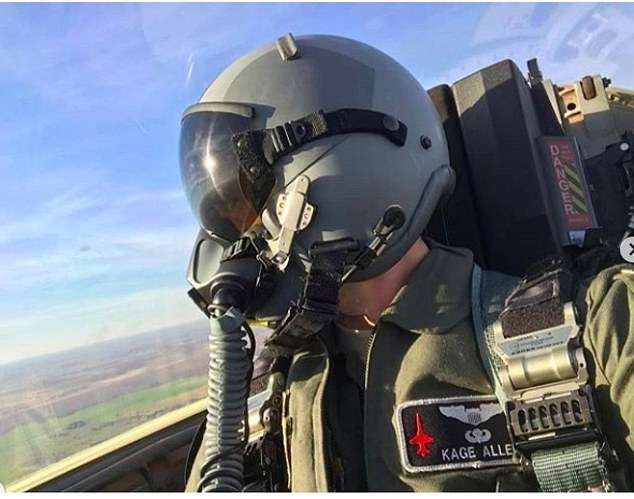An F-15C pilot’s fixation on an intercept during training, and failure to focus on the aircraft’s instruments as he encountered adverse weather, caused the fatal June 15 crash in the North Sea near the United Kingdom, U.S. Air Forces in Europe announced Nov. 23.
First Lt. Kenneth “Kage” Allen, 27, with the 493rd Fighter Squadron at RAF Lakenheath, U.K., was flying a local combat training flight with several other aircraft when the crash occurred.
“This unfortunate accident is yet another reminder of the inherent risks Airmen take on a daily basis to ensure the successes of our Air Force,” said Gen. Jeffrey L. Harrigian, U.S. Air Forces in Europe-Air Forces Africa commander, in a release. “Lt. Allen was an outstanding officer and a tremendous asset to the team. No words can compensate for such a painful and sudden loss.”
On the day of the crash, Allen’s F-15C, tail number 86-0176, was the No. 4 aircraft in a four-ship flight conducting a defensive counter-air sortie in the 48th Fighter Wing’s local airspace over the North Sea. The exercise included a total of nine F-15Cs and one F-15D, which was playing the role of adversary air.
The weather report that day included multiple cloud layers up to 25,000 feet, so the pilots were instructed to use Instrument Meteorological Conditions Rules during the training engagements if they encountered rough weather and needed to rely on the aircraft’s instruments. Under these rules, the aircraft’s maneuvering would be limited.
Allen was flying east at an altitude of about 20,300 feet when his element lead instructed him to make a hard right turn toward the west and search for an adversary aircraft flying at a lower altitude. Allen made the descending turn, used the aircraft’s on-board radar to find the adversary jet, and fired a simulated missile. He then stabilized at a westbound heading, descending to about 12,000 feet at 507 knots, or roughly 580 miles per hour.
The range training officer told Allen his shot likely missed, so he began a steep diving left turn to again intercept the adversary aircraft. His F-15 pulled up to 3.8 G forces, and accelerated to 570 knots, or just over 650 miles per hour, while descending at a rate of 38,800 feet per minute. The F-15C dove to about 1,000 feet, then Allen abruptly pulled up to wings-level, pulling 8.2 Gs in an attempt to recover above the water.
The other pilots in the exercise told investigators that cloud layers were prevalent, both from 9,000 to 14,400 feet and 1,000 feet to 4,000 feet, meaning “the horizon was difficult if not impossible to discern below 9,000 feet,” according to the USAFE Accident Investigation Board report.
Investigators found that Allen changed his bank as he entered the cloud layer to comply with the instrument condition rules, but he did not adjust the low pitch attitude. When he passed through 10,000 feet and continued the intercept, he aggressively banked left, increasing his G forces and lowering the nose of the jet to 42 degrees. Allen approached the training floor of 4,000 feet while banked to the left at a 60-degree angle and accelerating.
The jet crashed into the sea while flying 566 knots, about 650 miles per hour.
“The [pilot’s] lack of awareness of accelerating through the briefed training floor of 4,000 feet clearly indicates [he] fixated on acquiring the [adversary], either visually or with his radar, and did not monitor his aircraft altitude, airspeed, and attitude cockpit instruments,” the report states. “As the [pilot] exited the low cloud layer at approximately 1,000 feet and ‘ground rush’ of the rapidly approaching ocean, [he] immediately sensed his low pitch attitude and position and initiated a recovery attempt of the [F-15], but was unable to complete the recovery based upon the low altitude and speed of his descent.”
The airspace environmental conditions and Allen’s spatial disorientation also contributed to the crash, according to the report.
Following the crash, the British coast guard coordinated the search for the wreckage, including a helicopter, lifeboats, and other maritime support along with several USAF and United Kingdom Royal Air Force aircraft. A Royal Navy surface vessel found the debris field about five hours later. Over the course of several weeks, search and salvage operations recovered much of the wreckage from the crash, the report states.
Allen arrived at RAF Lakenheath in February, having graduated from the F-15C flying training unit in January, and he qualified as an F-15C wingman in May. He had received high marks for performance in training, and was known in his squadron “as a hard worker who exerted significant effort studying and preparing for missions,” the investigation states.
“The loss of an Airman is never easy, and this aircraft accident was no exception,” said Col. Jason Camilletti, 48th Fighter Wing commander, in the release. “Our Liberty Wing community, especially the Reapers of the 493rd Fighter Squadron, was truly touched by the tremendous outpouring of support from families, friends, and partners around the globe in our time of grieving.”
The F-15C was completely destroyed at a loss of about $45 million.
